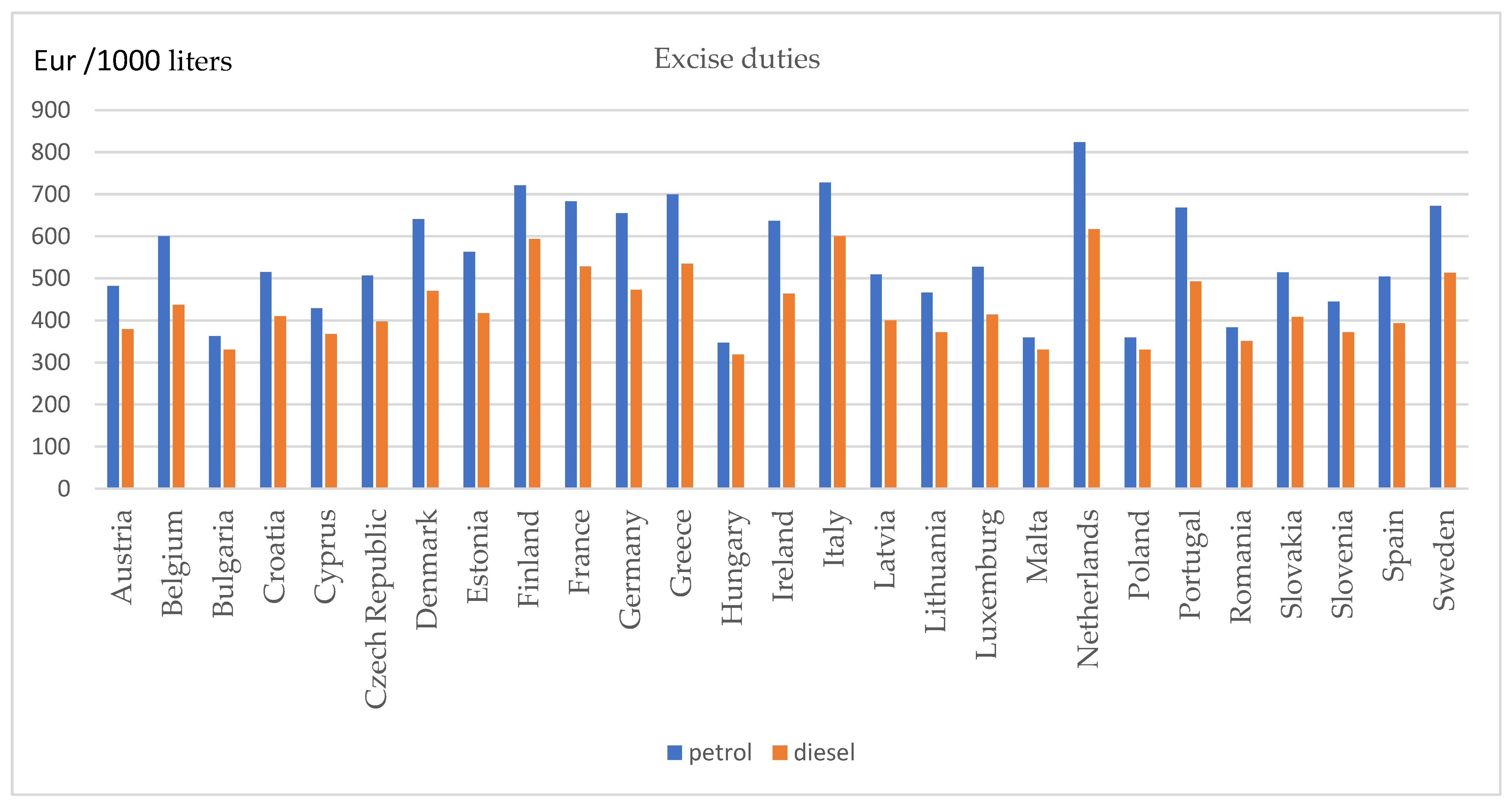Renewable Energies: Economic and Energy Impact in the Context of Increasing the Share of Electric Cars in EU
Abstract
1. Introduction
- Energy level, with three research directions (questions):
- Analyzing the current trends in producing and using renewable electricity within the EU
- Estimating the amount of electricity needed to replace current internal combustion engine vehicles with electric vehicles
- Evaluating the potential of renewable electricity to replace the current oil-based fuels;
- Economic level, with one research direction (question):
- Estimating the impact of replacing the current internal combustion engine cars with electric cars on the public budgets of the European Union member states.
2. Literature Review
3. Materials and Methods
- (1)
- Hydro
- (2)
- Wind
- (3)
- Solar
- (4)
- Other renewables including bioenergy
- -
- What is the trend of renewable energies in the EU and what can be achieved by 2028?
- -
- How much electrical energy is needed to replace current cars with electric cars?
- -
- Could this energy be obtained from green sources?
- -
- What would be the impact of this change on EU countries’ income from petrol and diesel excises?
- Exponential smoothing model (Simple, Holt’s linear trend, Brown’s linear trend, Damped trend).
- Autoregressive integrated moving average (ARIMA) model.
- -
- α is a smoothing factor and
- -
- is a weighted average of the current observation and the previous statistics
4. Results
4.1. Analysis of the Current Trends in Producing and Using Renewable Electricity
4.2. The Impact of Migration to Electric Cars
- Carbon footprint;
- Ecological impact;
- Energy independence of EU.
- Keep the energy prices under control
- Reduce their energy expenses.
5. Discussion and Conclusions
Author Contributions
Funding
Data Availability Statement
Conflicts of Interest
References
- Bórawski, P.; Wyszomierski, R.; Bełdycka-Bórawska, A.; Mickiewicz, B.; Kalinowska, B.; Dunn, J.W.; Rokicki, T. Development of Renewable Energy Sources in the European Union in the Context of Sustainable Development Policy. Energies 2022, 15, 1545. [Google Scholar] [CrossRef]
- Zamfir, A.; Colesca, S.E.; Corbos, R.A. Public policies to support the development of renewable energy in Romania: A review, Renew. Sustain. Energy Rev. 2016, 58, 87–106. [Google Scholar] [CrossRef]
- IEA. World Energy Outlook 2021; IEA: Paris, France, 2021; Available online: https://www.iea.org/reports/world-energy-outlook-2021 (accessed on 15 April 2022).
- Banca Nationala a Romaniei. Raportul Asupra Stabilitatii Financiare–Iunie 2022. 2022. Available online: https://www.bnr.ro/Raportul-asupra-stabilita%c8%9bii-financiare---iunie-2022-24352.aspx (accessed on 18 July 2022).
- IEA. Power Systems in Transition; IEA: Paris, France, 2020; Available online: https://www.iea.org/reports/power-systems-in-transition (accessed on 15 April 2022).
- World Energy Council. World Energy Pulse: Climate, COVID and Conflict Implications and Outlooks, April 2022. Available online: https://www.worldenergy.org/assets/downloads/World_Energy_Pulse_2022.pdf?v=1654602455 (accessed on 17 July 2022).
- Makieła, K.; Mazur, B.; Głowacki, J. The Impact of Renewable Energy Supply on Economic Growth and Productivity. Energies 2022, 15, 4808. [Google Scholar] [CrossRef]
- Gökgöz, F.; Güvercin, M.T. Energy security and renewable energy efficiency in EU. Renew. Sustain. Energy Rev. 2018, 96, 226–239. [Google Scholar] [CrossRef]
- Tvaronavičienė, M.; Plėta, T.; Della Casa, S.; Latvys, J. Cyber security management of critical energy infrastructure in national cybersecurity strategies: Cases of USA, UK, France, Estonia and Lithuania. Insights Into Reg. Dev. 2020, 2, 802–813. [Google Scholar] [CrossRef]
- Cao, J.; Chen, X.; Qiu, R.; Hou, S. Electric vehicle industry sustainable development with a stakeholder engagement system. Technol. Soc. 2021, 67, 101771. [Google Scholar] [CrossRef]
- Ternel, C.; Bouter, A.; Melgar, J. Life cycle assessment of mid-range passenger cars powered by liquid and gaseous biofuels: Comparison with greenhouse gas emissions of electric vehicles and forecast to 2030. Transp. Res. Part D 2021, 97, 102897. [Google Scholar] [CrossRef]
- Marino, A.; Pariso, P. The transition towards to the circular economy: European SMEs’ trajectories. Entrep. Sustain. Issues 2021, 8, 431–445. [Google Scholar] [CrossRef]
- Antonioli, D.; Chioatto, E.; Mazzanti, M. Innovations and the circular economy: A national and regional perspective. Insights Into Reg. Dev. 2022, 9, 57–70. [Google Scholar] [CrossRef]
- Sarma, U.; Karnitis, G.; Zuters, J.; Karnitis, E. District heating networks: Enhancement of the efficiency. Insights Into Reg. Dev. 2019, 1, 200–213. [Google Scholar] [CrossRef]
- Draghici, M. România–Oportunităţi şi riscuri pentru independenţa energetică, Ernst & Young, 16 mai 2022. 2022. Available online: https://www.ey.com/ro_ro/energy-reimagined/oportunitati-si-riscuri-pentru-independenta-energetica (accessed on 19 July 2022).
- Burchart-Korol, D.; Jursova, S.; Folega, P.; Korol, J.; Pustejovska, P.; Blaut, A. Environmental life cycle assessment of electric vehicles in Poland and the Czech Republic. J. Clean. Prod. 2018, 202, 476–487. [Google Scholar] [CrossRef]
- Burchart-Korol, D.; Jursova, S.; Folega, P.; Pustejovska, P. Life cycle impact assessment of electric vehicle battery charging in European Union countries. J. Clean. Prod. 2020, 257, 120476. [Google Scholar] [CrossRef]
- Rietmann, N.; Hügler, B.; Lieven, T. Forecasting the trajectory of electric vehicle sales and the consequences for worldwide CO2 emissions. J. Clean. Prod. 2020, 261, 121038. [Google Scholar] [CrossRef]
- Shafique, M.; Azam, A.; Rafiq, M.; Luo, X. Life cycle assessment of electric vehicles and internal combustion engine vehicles: A case study of Hong Kong. Res. Transp. Econ. 2022, 91, 101112. [Google Scholar] [CrossRef]
- Yang, L.; Yu, B.; Yang, B.; Chen, H.; Malima, G.; Wei, Y.-M. Life cycle environmental assessment of electric and internal combustion engine vehicles in China. J. Clean. Prod. 2021, 285, 124899. [Google Scholar] [CrossRef]
- Wu, Z.; Wang, M.; Zheng, J.; Sun, X.; Zhao, M.; Wang, X. Life cycle greenhouse gas emission reduction potential of battery electric vehicle. J. Clean. Prod. 2018, 190, 462–470. [Google Scholar] [CrossRef]
- Shafique, M.; Luo, X. Environmental life cycle assessment of battery electric vehicles from the current and future energy mix perspective. J. Environ. Manag. 2022, 303, 114050. [Google Scholar] [CrossRef] [PubMed]
- Younes, A.; Fingerman, K.R.; Barrientos, C.; Carman, J.; Johnson, K.; Wallach, E.S. How the U.S. Renewable Fuel Standard could use garbage to pay for electric vehicles. Energy Policy 2022, 166, 112916. [Google Scholar] [CrossRef]
- Pablo-Romero, M.P.; Sanchez-Braza, A.; Galyan, A. Renewable energy use for electricity generation in transition economies: Evolution, targets and promotion policies. Renew. Sustain. Energy Rev. 2021, 138, 110481. [Google Scholar] [CrossRef]
- IEA. Share of Global Final Energy Consumption by fuel in the Sustainable Development Scenario, 2000–2040; IEA: Paris, France, 2020; Available online: https://www.iea.org/data-and-statistics/charts/share-of-global-final-energy-consumption-by-fuel-in-the-sustainable-development-sce (accessed on 15 April 2022).
- Thimet, P.J.; Mavromatidis, G. Review of model-based electricity system transition scenarios: An analysis, for Switzerland, Germany, France, and Italy. Renew. Sustain. Energy Rev. 2022, 159, 112102. [Google Scholar] [CrossRef]
- Kyriakopoulos, G.L.; Arabatzis, G. Electrical energy storage systems in electricity generation: Energy policies, innovative technologies, and regulatory regimes. Renew. Sustain. Energy Rev. 2016, 56, 1044–1067. [Google Scholar] [CrossRef]
- Rahman, A.; Farrok, O.; Haque, M.M. Environmental impact of renewable energy source based electrical power plants: Solar, wind, hydroelectric, biomass, geothermal, tidal, ocean, and osmotic. Renew. Sustain. Energy Rev. 2022, 161, 112279. [Google Scholar] [CrossRef]
- REN21. Renewables 2022 Global Status Report; REN21: Paris, France, 2022; Available online: https://www.ren21.net/wp-content/uploads/2019/05/GSR2022_Full_Report.pdf (accessed on 15 July 2022).
- Ansarin, M.; Ghiassi-Farrokhfal, Y.; Ketter, W.; Collins, J. A review of equity in electricity tariffs in the renewable energy era. Renew. Sustain. Energy Rev. 2022, 161, 112333. [Google Scholar] [CrossRef]
- Fatoki, O. Determinants of hotel employees’ electricity saving intention: Extending the theory of planned behaviour. Entrep. Sustain. Issues 2020, 8, 86–97. [Google Scholar] [CrossRef]
- Nguyen, V.P.; Tran, T.K. Explicating Energy Saving Intention from the Prospect of Small Medium Enterprises. Entrep. Sustain. Issues 2020, 8, 716–734. [Google Scholar] [CrossRef] [PubMed]
- Gawel, E.; Strunz, S.; Lehmann, P. A Public Choice View on the Climate and Energy Policy Mix in the EU-How Do the Emissions Trading Scheme and Support for Renewable Energies Interact? Energy Policy 2014, 64, 175–182. [Google Scholar] [CrossRef]
- Lean, H.H.; Smyth, R. Will Policies to Promote Renewable Electricity Generation Be Effective? Evidence from Panel Stationarity and Unit Root Tests for 115 Countries. Renew. Sustain. Energy Rev. 2013, 22, 371–379. [Google Scholar] [CrossRef]
- Stigka, E.K.; Paravantis, J.A.; Mihalakakou, G.K. Social Acceptance of Renewable Energy Sources: A Review of Contingent Valuation Applications. Renew. Sustain. Energy Rev. 2014, 32, 100–106. [Google Scholar] [CrossRef]
- Zamfir, A. Developing Urban Renewable Energy Projects: Opportunities and Challenges for Romania. Theor. Empir. Res. Urban Manag. 2014, 9, 52–64. [Google Scholar]
- Zamfir, A. Managementul Strategic al Serviciilor de Valorificare Regională a Energiei Regenerabile; Editura ASE: Bucharest, Romania, 2013. (In Romanian) [Google Scholar]
- Sánchez, A.S.; Torres, E.A.; Kalid, R.A. Renewable energy generation for the rural electrification of isolated communities in the Amazon Region. Renew. Sustain. Energy Rev. 2015, 49, 278–290. [Google Scholar] [CrossRef]
- Blum, N.U.; Wakeling, R.S.; Schmidt, T.S. Rural electrification through village grids–Assessing the cost competitiveness of isolated renewable energy technologies in Indonesia. Renew. Sustain. Energy Rev. 2013, 22, 482–496. [Google Scholar] [CrossRef]
- Mboumboue, E.; Njomo, D. Potential contribution of renewables to the improvement of living conditions of poor rural households in developing countries: Cameroon’s case study. Renew. Sustain. Energy Rev. 2016, 61, 266–279. [Google Scholar] [CrossRef]
- Pîrlogea, C. Investments for a Sustainable Energy Future. Bus. Excell. Manag. 2012, 2, 21–30. [Google Scholar]
- Leva, S.; Zaninelli, D. Sustainable Energy and Economic Evaluation in Stand-Alone Photovoltaic Systems. In Proceedings of the 2006 IASME/WSEAS International Conference on Energy & Environmental Systems, Chalkida, Greece, 8–10 May 2006; pp. 76–82. [Google Scholar]
- Sovacool, B.K. The Intermittency of Wind, Solar, and Renewable Electricity Generators: Technical Barrier or Rhetorical Excuse? Util. Policy 2009, 17, 288–296. [Google Scholar] [CrossRef]
- Applica & Ismeri Europa. Inception Report, Expert Evaluation Network Delivering Policy Analysis, Contract No. 2010.CE.16.B.A.T.041. 2011. Available online: http://ec.europa.eu/regional_policy/sources/docgener/evaluation/pdf/eval2007/expert_innovation/ince (accessed on 6 July 2022).
- Hernandez Moreno, S. Current Technologies Applied to Urban Sustainable Development. Theor. Empir. Res. Urban Manag. 2009, 4, 125–140. [Google Scholar]
- Georgescu, S.D. The Moral Manager: Regaining Ethics for Business. Bus. Excell. Manag. 2013, 3, 24–29. [Google Scholar]
- ECORYS. Non-Cost Barriers to Renewables-AEON Study Romania. Final Report. 2010. Available online: http://ec.europa.eu/energy/renewables/studies/doc/renewables/2010_non_cost_barriers_countries.zip (accessed on 6 July 2022).
- Verboncu, I. Steps to Excellence in the Industrial Enterprises Management. Bus. Excell. Manag. 2013, 3, 5–23. [Google Scholar]
- Bordons, C.; García-Torres, F.; Valverde, L. Gestión Óptima de la Energía en Microredes con Generación Renovable. Rev. Iberoam. de Automática e Inf. Ind. 2015, 12, 117–132. (In Spanish) [Google Scholar] [CrossRef]
- European Commission. Renewable Energy Targets. 2022. Available online: https://energy.ec.europa.eu/topics/renewable-energy/renewable-energy-directive-targets-and-rules/renewable-energy-targets_en (accessed on 20 July 2022).
- Croce, A.I.; Musolino, G.; Rindone, C.; Vitetta, A. Sustainable mobility and energy resources: A quantitative assessment of transport services with electrical vehicles. Renew. Sustain. Energy Rev. 2019, 113, 109236. [Google Scholar] [CrossRef]
- Gutierrez-Garcia, F.; Arcos-Vargas, A.; Gomez-Exposito, A. Robustness of electricity systems with nearly 100% share of renewables: A worst-case study. Renew. Sustain. Energy Rev. 2022, 155, 111932. [Google Scholar] [CrossRef]
- Guo, D.; Yan, W.; Gao, X.; Hao, Y.; Xu, Y.; Wenjuan, E.; Tan, X.; Zhang, T. Forecast of passenger car market structure and environmental impact analysis in China. Sci. Total Environ. 2021, 772, 144950. [Google Scholar] [CrossRef] [PubMed]
- Collett, K.A.; Bhagavathy, S.M.; McCulloch, M.D. Forecast of electric vehicle uptake across counties in England: Dataset from S-curve analysis. Data Brief 2021, 39, 107662. [Google Scholar] [CrossRef] [PubMed]
- Bastida-Molina, P.; Hurtado-Pérez, E.; Peñalvo-López, E.; Moros-Gómez, M.C. Assessing transport emissions reduction while increasing electric vehicles and renewable generation levels. Transp. Res. Part D 2020, 88, 102560. [Google Scholar] [CrossRef]
- Supply, Transformation and Consumption of Oil and Petroleum Products. Available online: https://ec.europa.eu/eurostat/databrowser/view/NRG_CB_OIL__custom_3074042/default/table?lang=en (accessed on 16 July 2022).
- Electricity Production by Source, European Union (27). Available online: https://ourworldindata.org/grapher/electricity-prod-source-stacked?country=~European+Union+%2827%29 (accessed on 11 September 2022).
- Brown, R.G. Smoothing Forecasting and Prediction of Discrete Time Series; Prentice-Hall: Englewood Cliffs, NJ, USA, 1963. [Google Scholar]
- Brown, R.G. Exponential Smoothing for Predicting Demand; Arthur D. Little Inc.: Cambridge, MA, USA, 1956; p. 15. [Google Scholar]
- Hyndman, R.J.; Athanasopoulos, G. Forecasting: Principles and Practice, 2nd ed.; OTexts: Melbourne, Australia, 2018. [Google Scholar]
- Bloomberg NEF. Electric Vehicle Outlook. 2022. Available online: https://about.bnef.com/electric-vehicle-outlook/ (accessed on 16 July 2022).
- IEA. Global EV Outlook 2022 Securing Supplies for an Electric Future. 2022. Available online: https://iea.blob.core.windows.net/assets/ad8fb04c-4f75-42fc-973a-6e54c8a4449a/GlobalElectricVehicleOutlook2022.pdf (accessed on 15 July 2022).
- Albatayneh, A.; Assaf, M.N.; Alterman, D.; Jaradat, M. Comparison of the Overall Energy Efficiency for Internal Combustion Engine Vehicles and Electric Vehicles. Environ. Clim. Technol. 2020, 24, 669–680. [Google Scholar] [CrossRef]
- US Department of Energy. Alternative Fuels Data Center, Electric Vehicle Benefits and Considerations. 2022. Available online: https://afdc.energy.gov/fuels/electricity_benefits.html (accessed on 17 November 2022).
- Myth Buster: Electric Vehicles Will Overload the Power Grid. Available online: https://www.virta.global/blog/myth-buster-electric-vehicles-will-overload-the-power-grid (accessed on 16 July 2022).
- TEDB—“Taxes in Europe” Database. Available online: https://taxation-customs.ec.europa.eu/online-services/online-services-and-databases-taxation/tedb-taxes-europe-database_en (accessed on 22 November 2022).
- Search Tax (Simple). Available online: https://ec.europa.eu/taxation_customs/tedb/taxSearch.html/ (accessed on 22 November 2022).
- INS. Available online: https://insse.ro/cms/ro (accessed on 18 July 2022).
- Gustafsson, T.; Johansson, A. Comparison between Battery Electric Vehicles and Internal Combustion Engine Vehicles Fueled by Electrofuels. From an Energy Efficiency and Cost Perspective. Master’s Thesis, Department of Energy and Environment, Chalmers University of Technology, Gothenburg, Sweden, 2015. Available online: https://publications.lib.chalmers.se/records/fulltext/218621/218621.pdf (accessed on 16 November 2022).
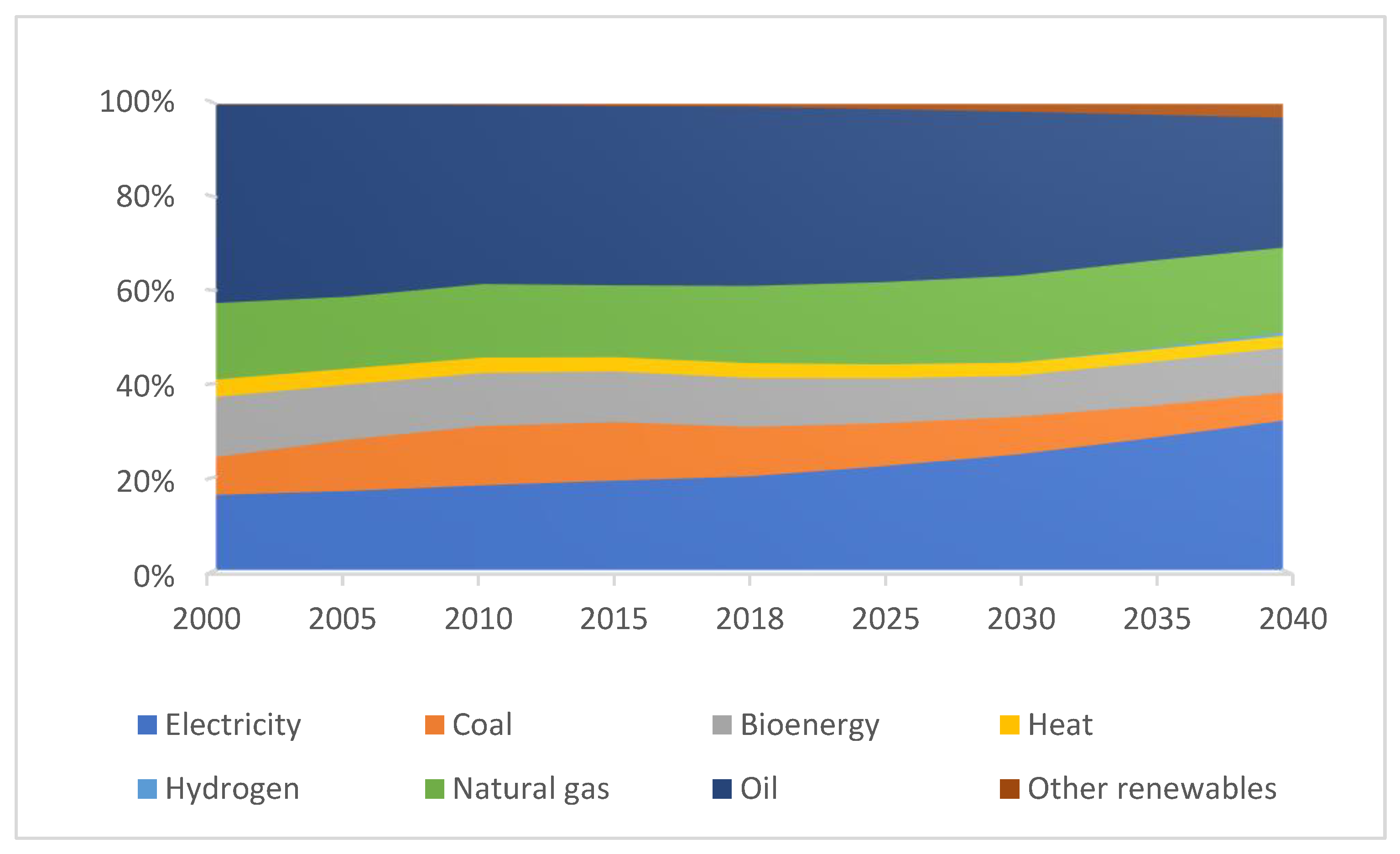
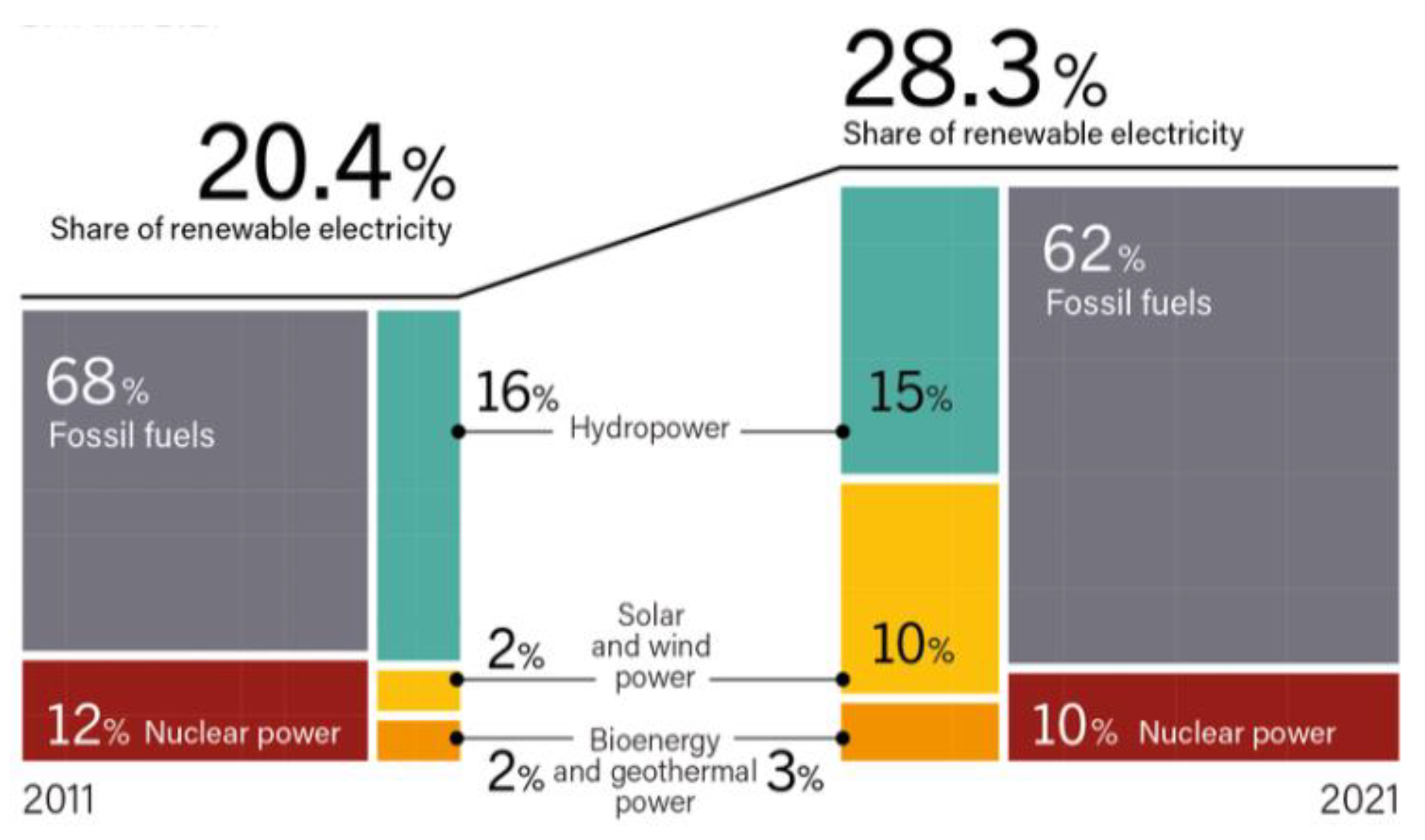
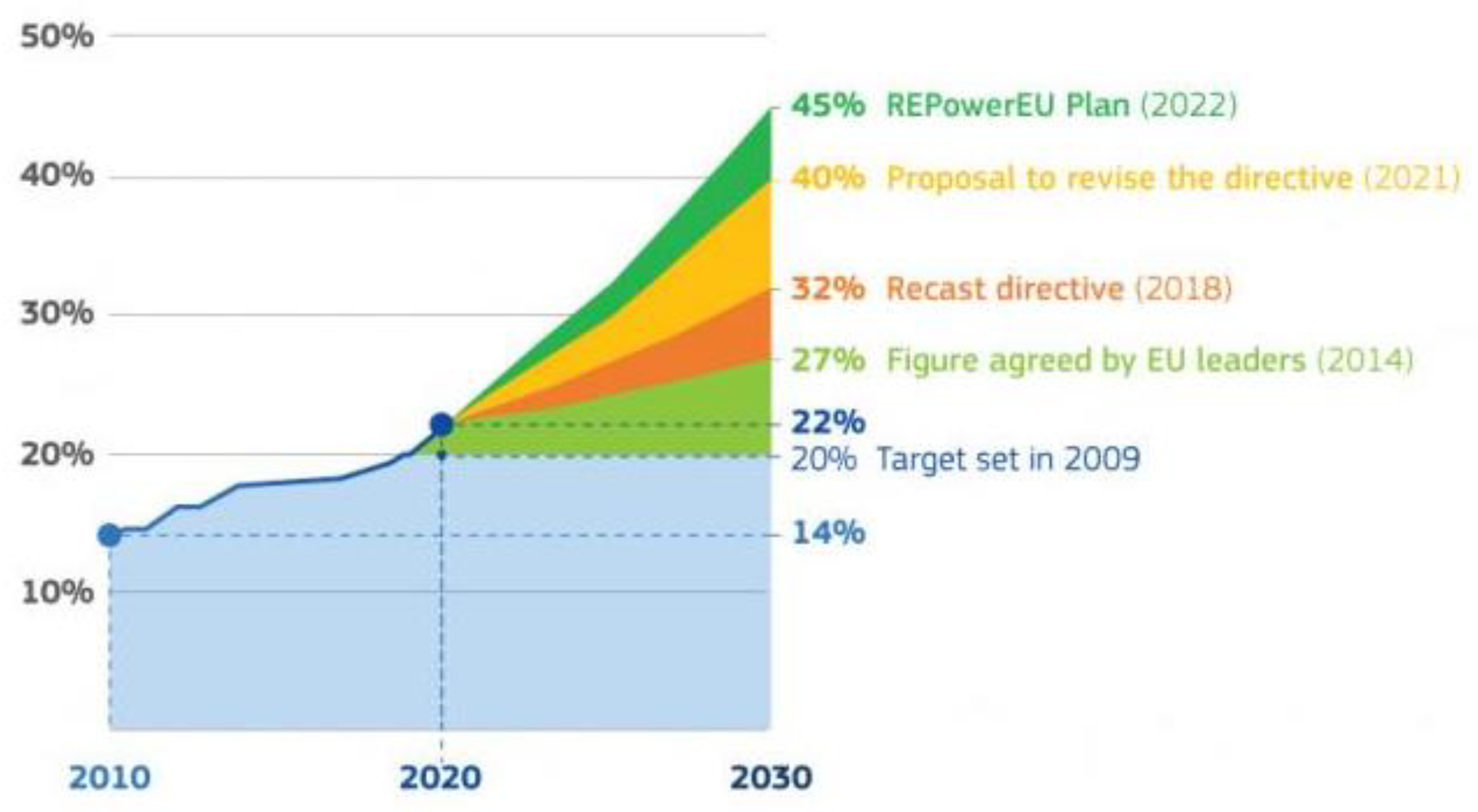
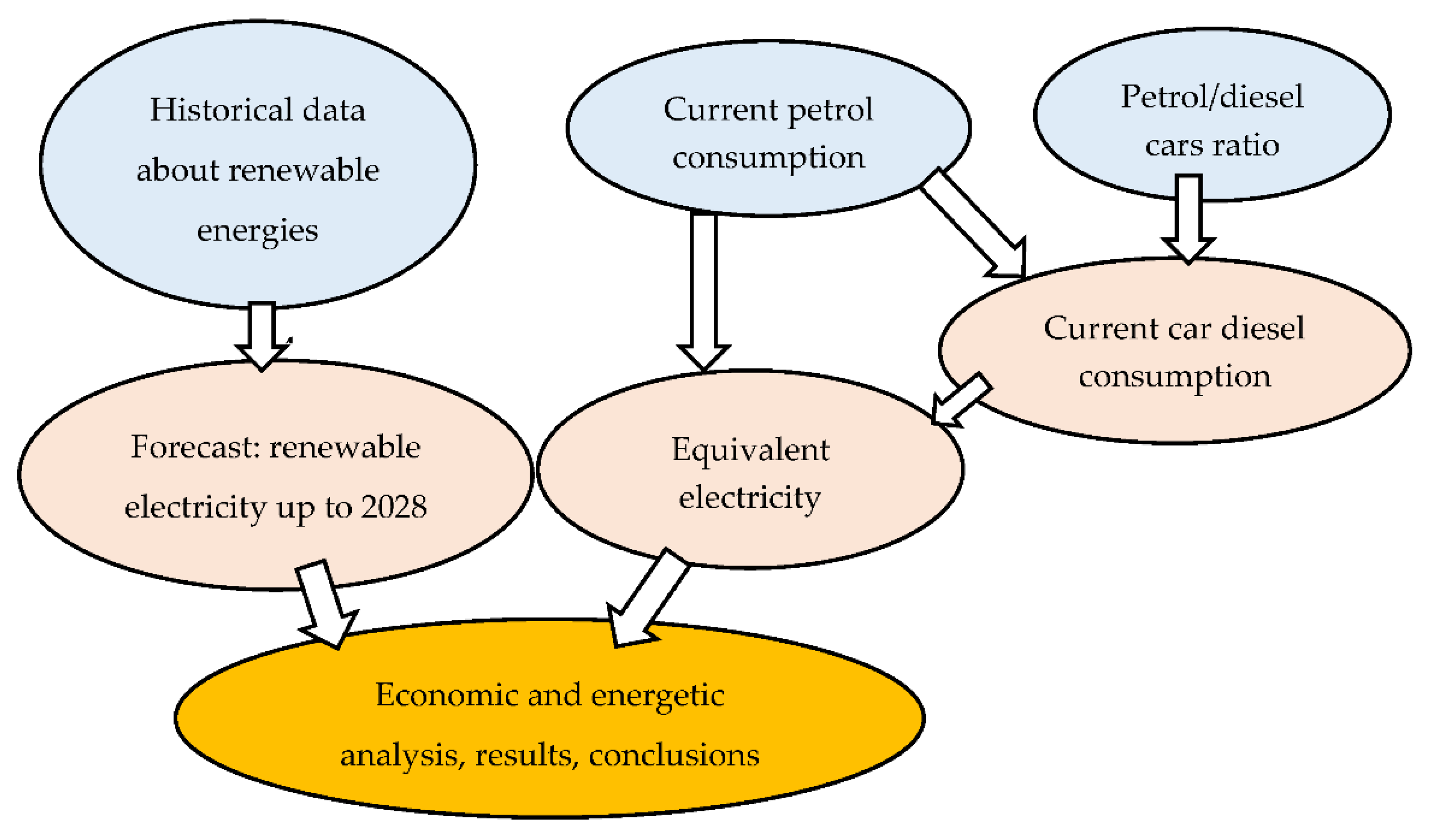

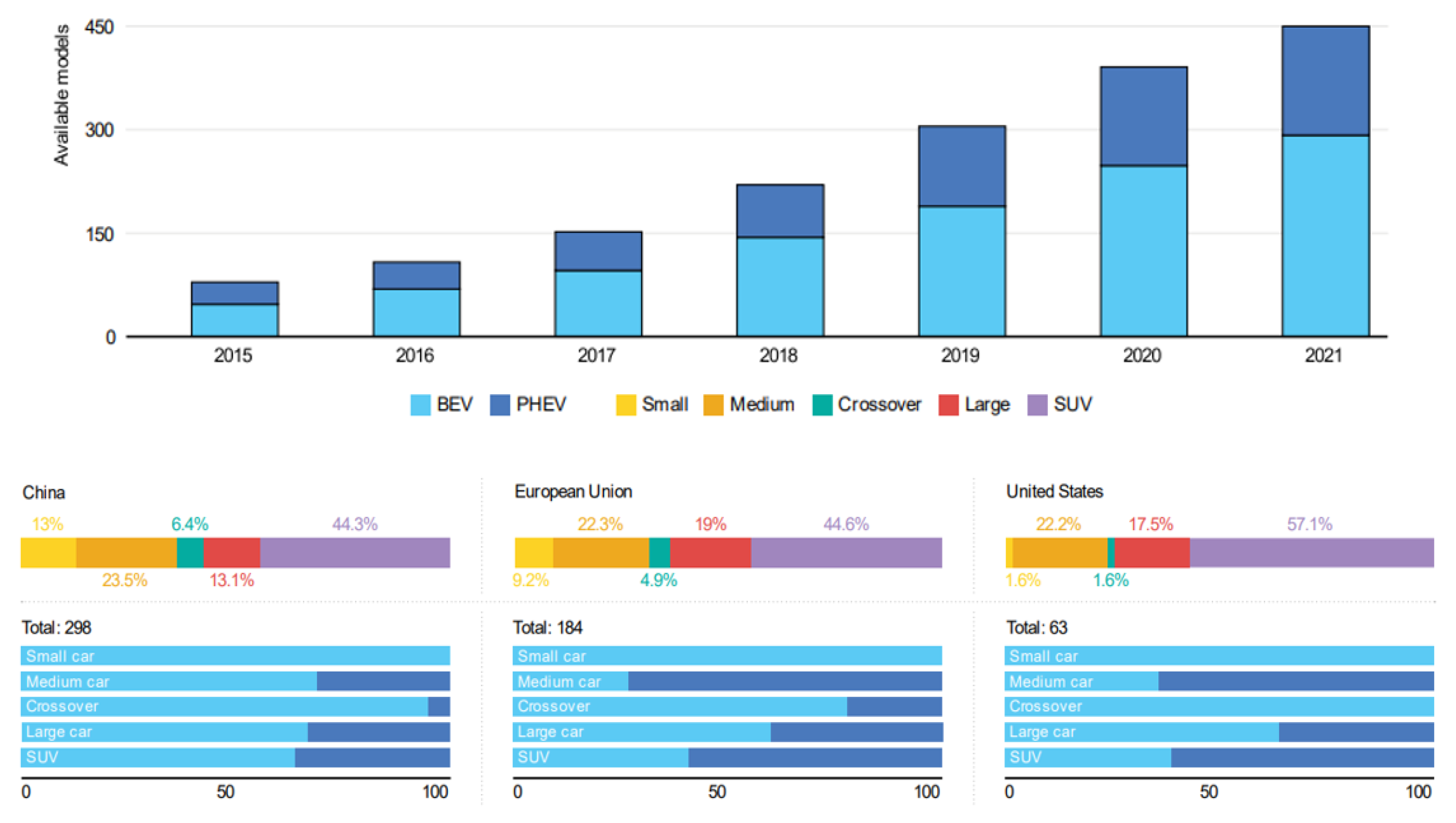
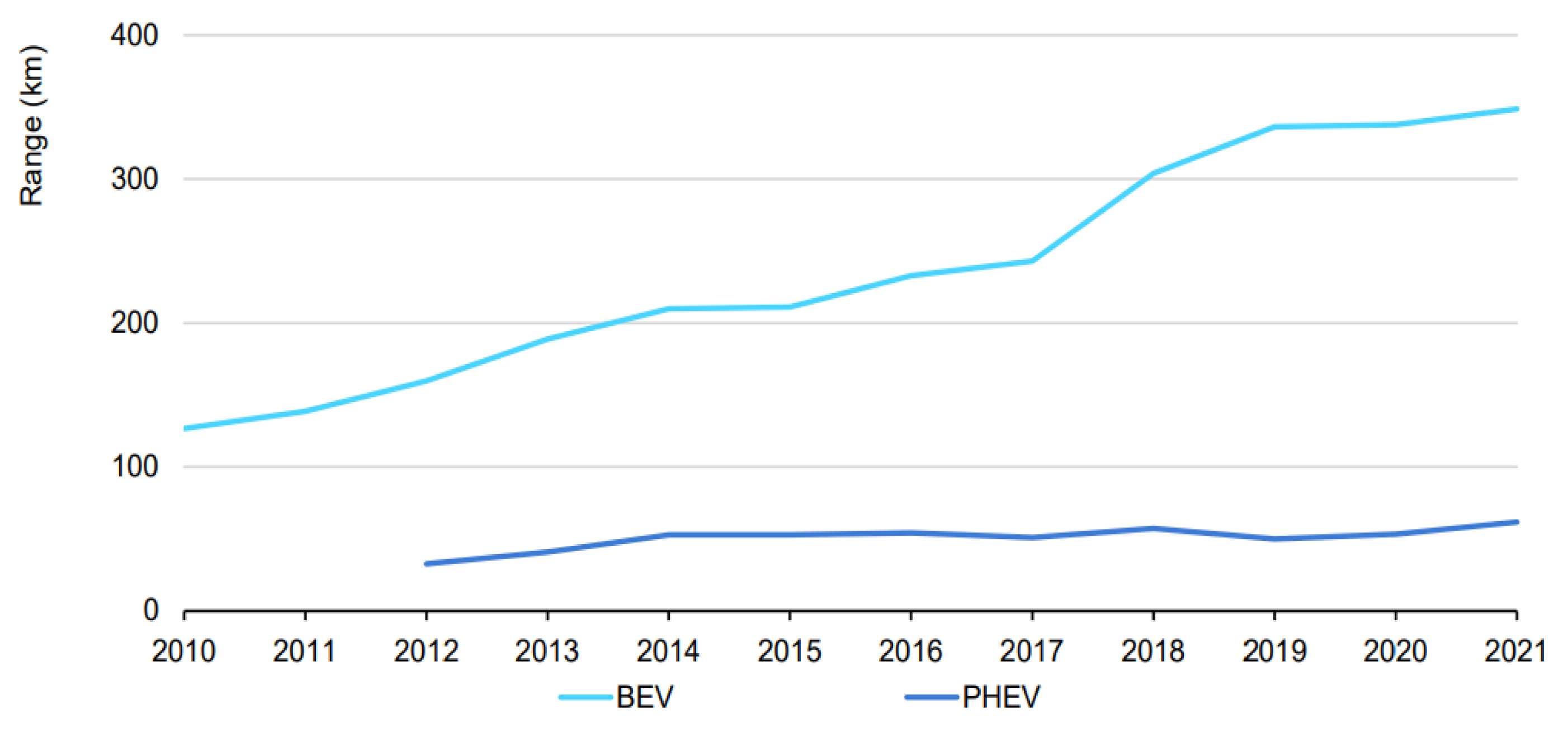
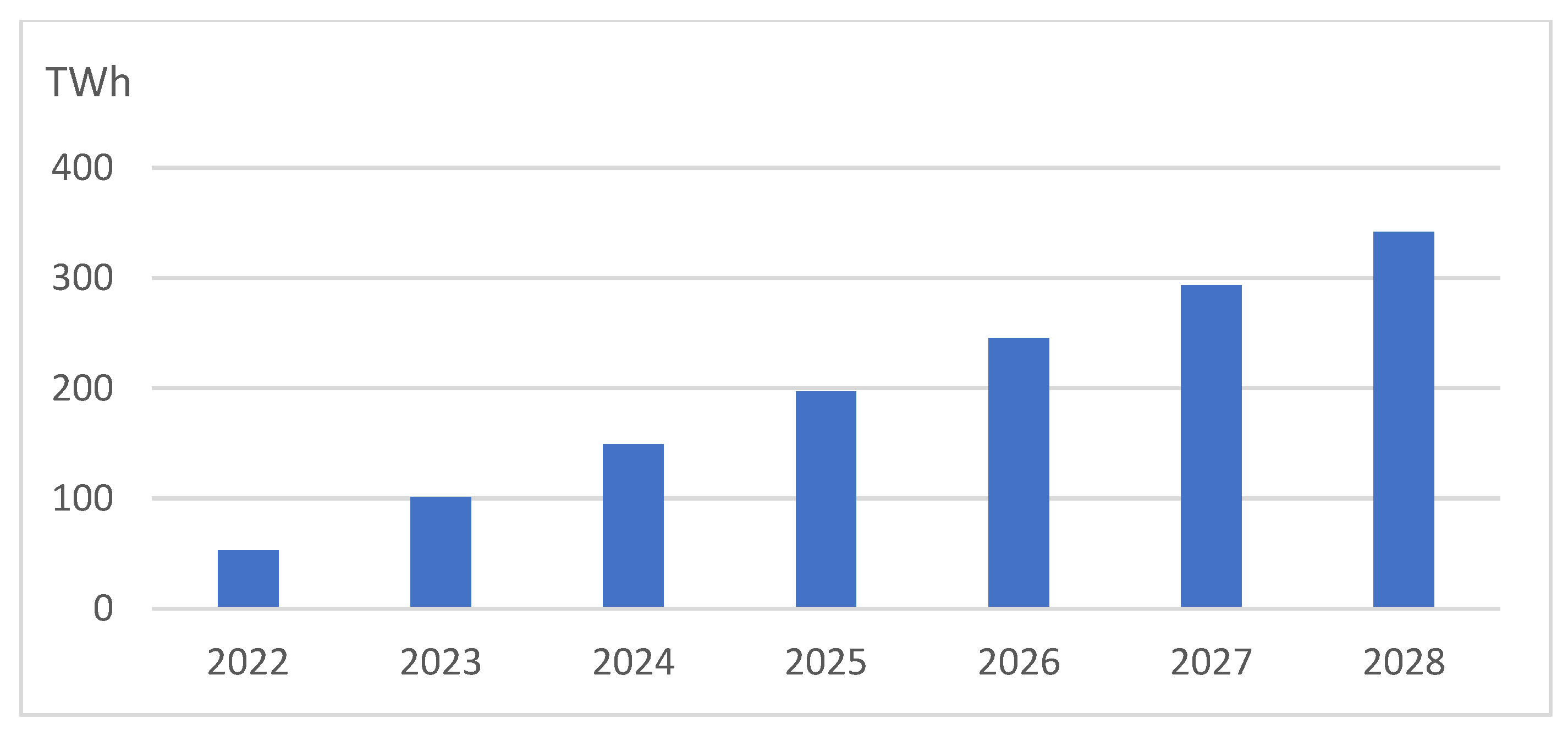
| Year | Hydro | Wind | Solar | Other Renewables | Total |
|---|---|---|---|---|---|
| 1990 | 301.5195 | 0.7705 | 0.0115 | 17.3430 | 319.6445 |
| 1991 | 315.5768 | 0.9710 | 0.0135 | 17.8698 | 334.4311 |
| 1992 | 329.2158 | 1.5020 | 0.0221 | 18.7209 | 349.4608 |
| 1993 | 335.1718 | 2.0674 | 0.0284 | 20.5868 | 357.8544 |
| 1994 | 344.2566 | 2.6346 | 0.0297 | 21.3220 | 368.2430 |
| 1995 | 346.6471 | 3.4705 | 0.0388 | 23.4366 | 373.5929 |
| 1996 | 350.5395 | 4.3390 | 0.0408 | 23.3871 | 378.3064 |
| 1997 | 353.6132 | 6.6259 | 0.0499 | 27.9160 | 388.2051 |
| 1998 | 367.4733 | 10.2874 | 0.0591 | 30.9709 | 408.7908 |
| 1999 | 367.2469 | 13.3530 | 0.0692 | 31.6421 | 412.3112 |
| 2000 | 379.1029 | 21.4226 | 0.0572 | 34.4540 | 435.0367 |
| 2001 | 401.9984 | 25.8486 | 0.1738 | 37.5481 | 465.5689 |
| 2002 | 345.6815 | 35.0665 | 0.2912 | 43.0938 | 424.1330 |
| 2003 | 335.7214 | 43.2969 | 0.4411 | 49.0716 | 428.5310 |
| 2004 | 355.2682 | 57.5040 | 0.7224 | 58.5947 | 472.0893 |
| 2005 | 340.5470 | 68.1063 | 1.4766 | 66.7623 | 476.8922 |
| 2006 | 342.7094 | 78.7095 | 2.5264 | 75.9177 | 499.8631 |
| 2007 | 338.8918 | 99.9123 | 3.8266 | 84.6918 | 527.3225 |
| 2008 | 354.8763 | 113.2300 | 7.5265 | 94.2254 | 569.8583 |
| 2009 | 357.6626 | 124.3197 | 14.2410 | 103.1748 | 599.3981 |
| 2010 | 401.2794 | 139.2597 | 23.3477 | 117.3570 | 681.2439 |
| 2011 | 332.8492 | 164.5123 | 46.6411 | 125.2723 | 669.2749 |
| 2012 | 359.5532 | 187.3884 | 70.2163 | 139.5604 | 756.7184 |
| 2013 | 396.6519 | 209.5217 | 83.4164 | 146.5854 | 836.1754 |
| 2014 | 398.6117 | 220.7715 | 91.9333 | 152.7763 | 864.0927 |
| 2015 | 363.2407 | 263.1045 | 98.8284 | 157.9100 | 883.0836 |
| 2016 | 372.7115 | 266.7841 | 99.0203 | 159.7005 | 898.2164 |
| 2017 | 322.4639 | 312.2943 | 105.8617 | 162.6998 | 903.3198 |
| 2018 | 370.2343 | 320.6057 | 112.5046 | 164.3521 | 967.6968 |
| 2019 | 345.6435 | 364.3421 | 123.2669 | 168.3245 | 1001.5771 |
| 2020 | 374.5344 | 397.3034 | 143.2808 | 170.0192 | 1085.1378 |
| 2021 | 344.3512 | 389.4972 | 160.6203 | 180.0787 | 1074.5474 |
| Series | Hydro | Wind | Solar | Other Renewables |
|---|---|---|---|---|
| R-squared | N/A | 0.995 | 0.993 | 0.998 |
| Forecasting model | ARIMA | Exponential smoothing | Exponential smoothing | Exponential smoothing |
| Year | Hydro | Wind | Solar | Other Renewables | Total |
|---|---|---|---|---|---|
| 2022 | 330.1959 | 434.3775 | 177.9599 | 185.5556 | 1128.0890 |
| 2023 | 330.1959 | 457.5404 | 195.2995 | 193.1911 | 1176.2270 |
| 2024 | 330.1959 | 480.7032 | 212.6391 | 200.8265 | 1224.3649 |
| 2025 | 330.1959 | 503.8661 | 229.9787 | 208.4620 | 1272.5028 |
| 2026 | 330.1959 | 527.0290 | 247.3183 | 216.0974 | 1320.6407 |
| 2027 | 330.1959 | 550.1918 | 264.6580 | 223.7328 | 1368.7786 |
| 2028 | 330.1959 | 573.3547 | 281.9976 | 231.3683 | 1416.9165 |
| Year | Electricity from Hydro Share | Electricity from Wind Share | Electricity from Solar Share | Other Renewable Electricity Share | Total Renewable Electricity Share |
|---|---|---|---|---|---|
| 2021 | 8.80% | 9.96% | 4.11% | 4.60% | 27.47% |
| 2028 | 7.17% | 12.48% | 6.14% | 5.04% | 30.83% |
| Engine Type | Consumption per 100 km | Conversion Factor to Electric Engine (kWh/L) | Fuel Consumption in EU * in 2021 (Thousand Tons) | Equivalent Electricity Consumption (GWh) |
|---|---|---|---|---|
| Petrol | 6 L | 2.5 kWh/L | 68,934.952 | 172,337.380 |
| Diesel | 5 L | 3 kWh/L | 47,001.103 | 141,003.310 |
| Electric | 15 kWh | n/a | n/a | n/a |
| Country | Petrol [50] (Tons) | Diesel (Tons) Estimated | Petrol Taxes (Excluding VAT) EUR | Diesel Taxes (Excluding VAT) EUR | Total Taxes (Excluding VAT) EUR |
|---|---|---|---|---|---|
| Austria | 1,440,356 | 1,412,853 | 694,251,592 | 535,471,444 | 1,229,723,036 |
| Belgium | 2,020,500 | 1,536,652 | 1,212,300,000 | 671,516,995 | 1,883,816,995 |
| Bulgaria | 533,136 | n/a | 193,528,368 | n/a | 193,528,368 |
| Croatia | 445,262 | 467,272 | 229,309,930 | 191,581,647 | 420,891,577 |
| Cyprus | 299,160 | 65,207 | 128,339,640 | 23,996,200 | 152,335,840 |
| Czech Republic | 1,516,000 | 823,925 | 768,612,000 | 327,098,281 | 1,095,710,281 |
| Denmark | 1,316,000 | 467,300 | 843,556,000 | 219,630,836 | 1,063,186,836 |
| Estonia | 207,000 | 113,151 | 116,541,000 | 47,184,004 | 163,725,004 |
| Finland | 1,481,000 | 423,161 | 1,067,801,000 | 251,357,587 | 1,319,158,587 |
| France | 9,148,102 | 10,165,353 | 6,248,153,666 | 5,367,306,486 | 11,615,460,152 |
| Germany | 19,215,000 | 7,364,458 | 12,585,825,000 | 3,483,388,408 | 16,069,213,408 |
| Greece | 2,033,938 | n/a | 1,423,756,600 | n/a | 1,423,756,600 |
| Hungary | 1,515,000 | 587,645 | 525,705,000 | 187,458,703 | 713,163,703 |
| Ireland | 598,476 | n/a | 381,229,212 | n/a | 381,229,212 |
| Italy | 7,237,883 | 5,432,539 | 5,269,178,824 | 3,259,523,352 | 8,528,702,176 |
| Latvia | 169,472 | 283,138 | 86,261,248 | 113,255,190 | 199,516,438 |
| Lithuania | 253,200 | 548,572 | 117,991,200 | 204,068,693 | 322,059,893 |
| Luxembourg | 336,300 | 312,558 | 177,230,100 | 129,399,022 | 306,629,122 |
| Malta | 75,872 | 28,397 | 27,238,048 | 9,370,923 | 36,608,971 |
| Netherlands | 3,819,644 | 455,767 | 3,147,386,656 | 281,208,104 | 3,428,594,760 |
| Poland | 4,876,921 | 2,349,662 | 1,750,814,639 | 775,388,507 | 2,526,203,146 |
| Portugal | 963,205 | 1,054,995 | 643,420,940 | 520,112,369 | 1,163,533,309 |
| Romania | 1,401,000 | 1,057,859 | 536,583,000 | 371,308,674 | 907,891,674 |
| Slovakia | 553,011 | n/a | 284,247,654 | n/a | 284,247,654 |
| Slovenia | 368,680 | 310,508 | 164,062,600 | 115,509,021 | 279,571,621 |
| Spain | 5,188,251 | 5,026,995 | 2,614,878,504 | 1,975,608,927 | 4,590,487,431 |
| Sweden | 1,922,583 | 926,753 | 1,291,975,776 | 475,424,059 | 1,767,399,835 |
| EU27 | 68,934,952 | 41,214,719 | 42,530,178,197 | 19,536,167,431 | 62,066,345,628 |
Publisher’s Note: MDPI stays neutral with regard to jurisdictional claims in published maps and institutional affiliations. |
© 2022 by the authors. Licensee MDPI, Basel, Switzerland. This article is an open access article distributed under the terms and conditions of the Creative Commons Attribution (CC BY) license (https://creativecommons.org/licenses/by/4.0/).
Share and Cite
Zamfir, A.-I.; Croitoru, E.O.; Burlacioiu, C.; Dobrin, C. Renewable Energies: Economic and Energy Impact in the Context of Increasing the Share of Electric Cars in EU. Energies 2022, 15, 8882. https://doi.org/10.3390/en15238882
Zamfir A-I, Croitoru EO, Burlacioiu C, Dobrin C. Renewable Energies: Economic and Energy Impact in the Context of Increasing the Share of Electric Cars in EU. Energies. 2022; 15(23):8882. https://doi.org/10.3390/en15238882
Chicago/Turabian StyleZamfir, Andreea-Ileana, Elena Oana Croitoru, Cristina Burlacioiu, and Cosmin Dobrin. 2022. "Renewable Energies: Economic and Energy Impact in the Context of Increasing the Share of Electric Cars in EU" Energies 15, no. 23: 8882. https://doi.org/10.3390/en15238882
APA StyleZamfir, A.-I., Croitoru, E. O., Burlacioiu, C., & Dobrin, C. (2022). Renewable Energies: Economic and Energy Impact in the Context of Increasing the Share of Electric Cars in EU. Energies, 15(23), 8882. https://doi.org/10.3390/en15238882






